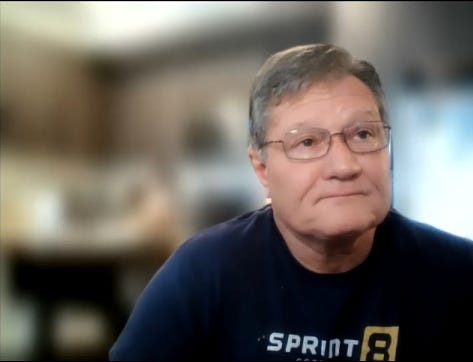TPM #259. Speed Training, The Great Advantage.
Key steps to helping our youth move quicker, have more fun and play more.
We are into June. The ½ way mark of 2024! Anyone else notice that time seems to be moving super fast?
Edition #258 explored helping young people move better. Edition #259 looks at the process of helping them move faster.
Why is moving fast in sport important?
First, let’s connect moving well with moving fast. Kids who move fast typically have developed efficient movement patterns. This often, not always, translates to moving faster.
What are the benefits of having our kids moving fast?
One of the first thing coaches notice is kids who move with speed. Moving well is determined by how fast (or slow) a young athlete moves. We can further (subjectively) also say that this is one of the first things that shapes a coach’s evaluation and helps determine opportunities to play. At the same time the child who moves slowly or slower than the rest is also noticed. This has the opposite effect. The slower moving kids have less opportunities to play.
A less skilled fast athlete will get more opportunities than a more skilled (in the sport) slower player. While this is subjective, I can tell you it is based on 30+ years of coaching and parental observation. It is a simple skill for the eyeball test.
Secondly, moving better and quicker will also enhance self-confidence. The young athlete who moves fast and gets opportunities to play will improve at the sport at a quicker pace. Competence in the sport breeds confidence.
In short, moving faster will enhance self-confidence and give the athlete more opportunities to play. Pretty good reasons to ensure that our young person develops some speed.
The consensus:
If you asked 10 skill coaches and 10 parents on how to help their young person increase speed, you would likely get a few different answers. A frequent one will be to do quick feet drills. What else would explain why we see ladders and the like now incorporated into practice? The other answer likely will be more conditioning drills. The challenge with that answer is that conditioning or building endurance does not improve technique on getting faster.
If we asked accredited strength and movement coaches, their answers will likely be different. Improving strength and power output will likely be their top answer followed by speed technique training.
These are different answers than what the parents and skills coaches would provide.
To the end of speed technique training, let’s revisit some of the work of 2 long time speed technique coaching experts, Phil Campbell and Lee Taft. These coaches each have 30 + years of movement and speed coaching experience and are well positioned to help us develop some solutions on the topic.
They are 2 examples of truly highlighting the value of a good movement coach.
From TPM February 2021 on Phil Campbell’s speed training:
Training the young athlete:
Effective speed training in the young adolescent athlete includes understanding that young people grow at different rates. Performance can be inconsistent when the body changes, but understanding the concepts of speed technique training can be refined and practiced over time. When the body growth spurts slow down, and strength built, then performance starts to accelerate.
Effective speed training usually only works well when the athlete is ready to be coached. Many mature faster than others in this area, with female athletes leading the way with quicker maturity. Coach Campbell often discusses this with athletes, coaches and parents prior to participating in his speed clinics.
The advanced athlete and speed technique training:
Many of Coach’s athletes come to Coach Phil later in their teenage years either in college sports on the verge. Their bodies have developed and improved through weight room work, but their speed has not improved as much. This is where going through the basics around warm up, speed drills for upper and lower body and practice becomes critical.
Phil’s speed training clinics cover these components as well as technique for a quick start, drive phase vs fly phase, lateral speed development as well as functional sport specific speed development.
Coach Lee Taft, from our TPM article here discussed this same concept but from a “how to teach it” perspective:
Example: tennis. if you look at the tennis serve, when the athlete prepares to serve. They are bouncing. Not very low, but have an elastic energy.
When they must move, for example when serve and return comes wide, they have reactive elastic responses.
There are also movements that require more power. Sharp cut to get to a ball. So the athlete requires more knee bend and hip load to get there. There is a heavier load on the body so they can execute.
As a coach, we need our athletes to do it all: ability to load low and need elastic energy.
We can teach that skill and have the athlete go through it and let them go. Let them develop.
Guide the learning path and don’t take it over.
Watch how they absorb that new skill. Don’t interfere with the learning process, only guide it.
This biggest problem I see is taking something holistic and natural and break it into parts too soon. We have to break it down into parts if and when the learning path gets distorted.
For example, instead of athlete going A to B, they are going to A to Z, if I give them a little interjection , I can get them back on track. That is what coaching is all about.
Example. If we take a 3 year old and want to teach them how to ride a bike. You can help with hands and how to sit, but until they get a feel for the balance, you cannot help them. They need to get a feel for the skill, a sense of what it feels like. Let their body discover.
Learning the skill is the same way.
Learn the elastic energy and power generation, then let the body figure it out and guide the process until they start to adopt it. Once re-enter the sport the skills will integrate into the sport.
Sports absorb the skills and makes them look like that sport.
Powerful perspectives from 2 of the greats.
In short, movement and speed training will enhance self- confidence, improve skills on the field and allow the athlete to develop their own knowledge base as well as their skills. They will get more opportunities to play, and be healthier.
A movement coach, someone who can coach your kids to help them move better has a strong role to play in helping our kids along this path. These are skills that can be taught and learned. Let’s get to work!
The Science of Speed Technique Training From Master Coach Phil Campbell.
Every Sunday I publish an email on leadership and human performance called The Physical Movement. It is our mission to share positive, educational and inspirational information on how we can be better. You can subscribe to be first in line every week here:
Interview with Lee Taft. Movement Engineer. Coach. Teacher. Speed Guy. Exercise Scientist. Business Person. Lessons from 30 Years Teaching Human Movement.
Good Sunday morning everyone. We have another treat this week, this week’s interview is with Lee Taft. I hope you enjoy it as much as I did putting this together. Some fascinating concepts and terrific insight.






